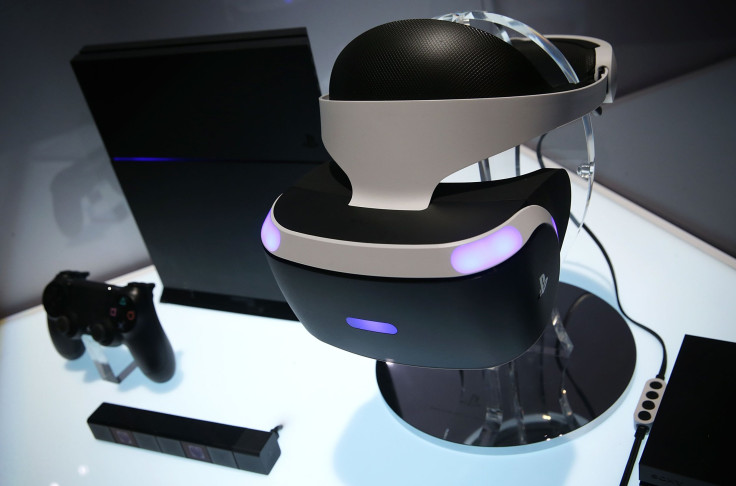PlayStation VR Promises To Bring Mainstream Virtual Reality To Your Living Room

The PlayStation VR might be getting into the game a little late, but it promises to bring virtual reality to the living room in a way that the Oculus Rift and HTC Vive haven't. Set to be released in October, Sony's VR headset could be the first to really hit the mainstream. Between Sony's expertise in console launches and the tens of millions of PS4 owners, the PlayStation VR has clear advantages over its competitors in the nascent VR market.
"We’ve done hardware before, lots of hardware, and we have a very good track record of knowing how to bring products to market," said Richard Marks, head of PlayStation Magic Lab.
The recent news of shipment delays for the Rift and Vive shows just how hard it is to launch a new VR product. From October until the end of the year, Marks expects to have 50 PlayStation VR titles available and many more in development. The long list of developers doing games for the PlayStation VR includes Capcom, Square Enix, Sega, 2K Games and Ubisoft, among many others.
Marks may have the best job at Sony as he pushes the boundaries of hardware at the company. He was behind the development of the PlayStation Move, a controller first released in 2010 for the PlayStation 3. The Move had some success in its initial run as a PlayStation 3 accessory, but its legacy could be the device that inspired the PlayStation VR.
PlayStation Move was being used as an improvised tracking device by different Sony teams around the world. People were strapping the Move on their head and connecting it to a display to create a rudimentary VR system. Soon the first prototypes were developed internally. Project Morpheus became a reality when it received the support of Kazuo Miura, head of global research and development, and Shuhei Yoshida, president of Worldwide Studios, Sony Interactive Entertainment.
First announced in 2015, Project Morpheus became PlayStation VR with a price of $399 and an October launch revealed a year later. The headset has pretty much all of the features you'd expect from a VR headset in 2016. It has a 5.7-inch, 1080p display and a field of view of 100 degrees, and it can hit a refresh rate of 120 frames per second. The field of view and resolution are slightly lower than what the Rift and Vive are capable of, but the PlayStation VR has a better refresh rate than both headsets.
Not all pixels are created equal, said Marks, noing that PlayStation VR has subpixel rendering capabilities and other technical features. But it ultimately comes down to the fact that everyone at Sony is really happy about the image quality and resolution of the PlayStation VR.
The reason why the PS4, though not as powerful as the PC necessary for the Rift or Vive, is able to pull off an impressive VR experience is because of the known nature of the architecture of the PS4. Every PC has different components, which can affect how a game runs. "We know everything about the console. We know every cycle of how it spends its time, so we can make things really targeted in real time," said Marks.
At a PlayStation VR event on April 7, members of the press were able to try many different experiences with the finalized headset design. The VR unit rests on the forehead, a slight departure from the goggle-based Rift and Vive. With games like "Headmaster," where a player heads soccer balls in a series of increasingly odd scenarios, or the horror experience "Rush of Blood" or rhythm shoot "Rez Infinite," each feels like a polished VR experience that players can quickly pick up and enjoy. Visual quality is impressive, but consumers will not be replacing their preferred HDTV or monitor anytime soon.
It's not always about haqving the best hardware. The Nintendo Wii easily won the last generation, but it was no match for the specs of the Xbox 360 or PlayStation 3. Innovation or software can turn the tide for any device, which is why Sony's strong relationship with developers is crucial to the potential success of the PlayStation VR.
"Gaming has kind of become mature. There’s still a lot of indie energy, but not in the same way on the technical side of things," said Marks. "Now, with VR on the market, it gives those guys a chance to be creative on the technical side."
Playstation VR includes a second-screen experience where other individuals can interact with the VR user via the DualShock 4 controller and follow the action on television. The bundled "Playroom VR" is a fun set of minigames that highlights how everyone can join in on the VR experience. "It’s something very unique to us because the console sits in the family room or living room," said Marks.
It’s easy to forget about the PS4 amid all this discussion of the upcoming PlayStation VR. The incredibly successful console is the fastest-selling ever for Sony, besting the pace of the venerable PS2, and will likely have over 40 million users by the time the PlayStation VR is released in October. Games such as “Uncharted 4: A Thief’s End” and “No Man’s Sky,” to be released in May and June, respectively, show the PS4 still has plenty of power to deliver incredible experiences as a standalone console. Unlike the Rift and the Vive, PlayStation VR doesn't need to be a hit for it to be a success for Sony.
© Copyright IBTimes 2024. All rights reserved.












